Active noise control
This research project is not currently active and this page is not regularly updated. It is provided here for archival purposes.
Active noise control
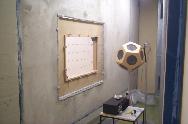
Noise is more and more perceived as an environmental pollutant. This shift in attitude is reflected in stricter legislation and has wide ranging economic consequences. Traditionally, noise was reduced by passive means like mufflers, damping plates, sound absorbing materials, double-glazing windows, noise barriers etc. All these passive means are mostly suitable for high frequencies and have various disadvantages. In the last decade, active control of sound and vibration (at audio frequencies) has emerged as a viable technology to bridge the low-frequency technology gap.
The general area considered is broadband noise transmitted to an enclosed area. We are investigating Active Structural Acoustic Control (ASAC) on the enclosure, and Active Noise Control (ANC) in the enclosed space. Our work tries to introduce novel aspects of multivariable control to this field and is focused on two problems. For the ASAC problem we want to develop techniques for the joint design of the "smart structure'', the placement of the sensors and actuators, and the synthesis of the control law. For ANC we propose to look at the three-dimensional problem with special emphasis on hitherto neglected aspects of feedback control.
The work builds on decades of experience at our lab in robust control, system identification and adaptive control and consists of a balance of simulation, theory and experimentation.
This project is supported by ETH Zurich and external page EMPA Dübendorf.
In collaboration with: Acoustics group of EMPA, the Centre of Structures Technologies at ETH and the external page University of Newcastle (Australia).
Projects in Active Noise and Vibration Control
Smart Damping Materials using Shunt Control
Active Noise Control (ANC)

Smart materials have long been heralded as the dawn of a new era in the construction of automotive vehicles, airplanes and other structures that have to meet ever more demanding performance requirements. This has largely not happened, at least not in the commercial arena. In this context dynamic behavior is one main design criterion for many kinds of load-carrying structures, as undesirable large-amplitude vibrations often impede the effective operation of various types of mechanical systems, including antennae, spacecrafts, rotorcrafts, automobiles, and sophisticated instruments. It is therefore desirable to introduce structural damping into a system to achieve a more satisfactory response and to delay fatigue damages.
The large instrumentation overhead of conventional vibration control can be significantly reduced by a new method that involves attaching an electrical shunt controller across the terminals of one piezoelectric transducer with the view to minimizing structural vibrations. This approach is referred to as piezoelectric shunt damping and is known as a simple, low-cost, lightweight and easy-to-implement method for vibration damping.
We are developing new adaptive resonant shunt circuits that can efficiently damp several structural modes and do not require power for operation.

The damping performance of resonant multi-mode shunts is highly sensitive. If the parameters of the piezoelectric transducer or the mechanical structure change, then the resonant shunt gets miss-tuned and loses its damping. Therefore, resonant shunts need to be tuned online.
A relative phase adaptation to online-tune resonant multi-mode shunts was proposed [1], [2]. It is based on the calculation of the relative phase between a reference signal and shunt current. However, direct calculation of the phase is not required. The relative phase adaptation can be expressed as
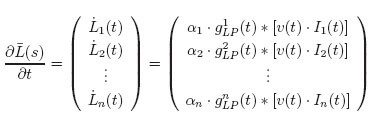
Experimental results validated the performance of the relative phase adaptation, where the resonance frequency of the mechanical structure was changed by an additional weight on the structure.
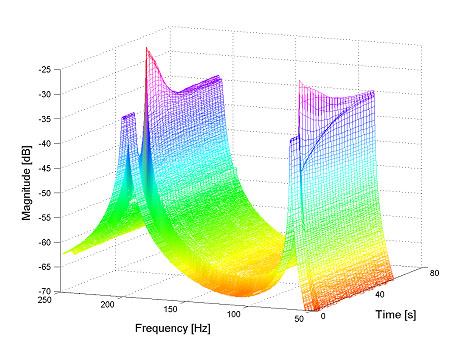
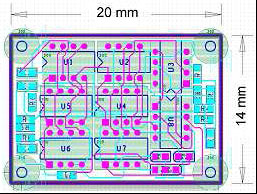
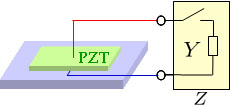
A completely autonomous shunt circuit was developed and implemented. It does not require any power for operation and its size is tiny. Experiments showed a vibration suppression of around 60%-70%.
The described shunt circuit is based on so called Switching Shunts. An optimal switching law was derived using the Hybrid System Framework. The obtained switching law was implemented with a few analog electronic components, such that the resulting circuit does not require power for operation. Additionally, the circuit can tune itself automatically [1].

In cooperation with external page EMPA in Dübendorf and IMES at ETH Zurich we are developing new Smart Damping Materials for the integration into fiber composite materials. These materials consist of Active Fiber Composites (AFCs) that are optimized in shape and structure. The AFCs are then shunted to electronic circuits with the aim to suppress vibration of the host structure.
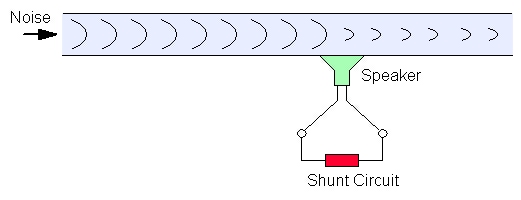
In this project, speakers are shunted to electronic circuits with the view to suppress acoustic noise. Experiments showed that acoustic modes of a duct can effectively be damped without the need of sensor microphones. More information can be found in [1].
This is a joint project with the external page University of Newcastle (Australia) and external page EMPA in Dübendorf.
Currently, we are investigating several applications for Smart Damping Materials, such as vibration control in cars, aeroplanes and disc brakes or noise control in double glazed windows and ducts.

The sound transmission loss of a double-glazed window is inreased by actively controlling the sound field in the cavity between the panels.